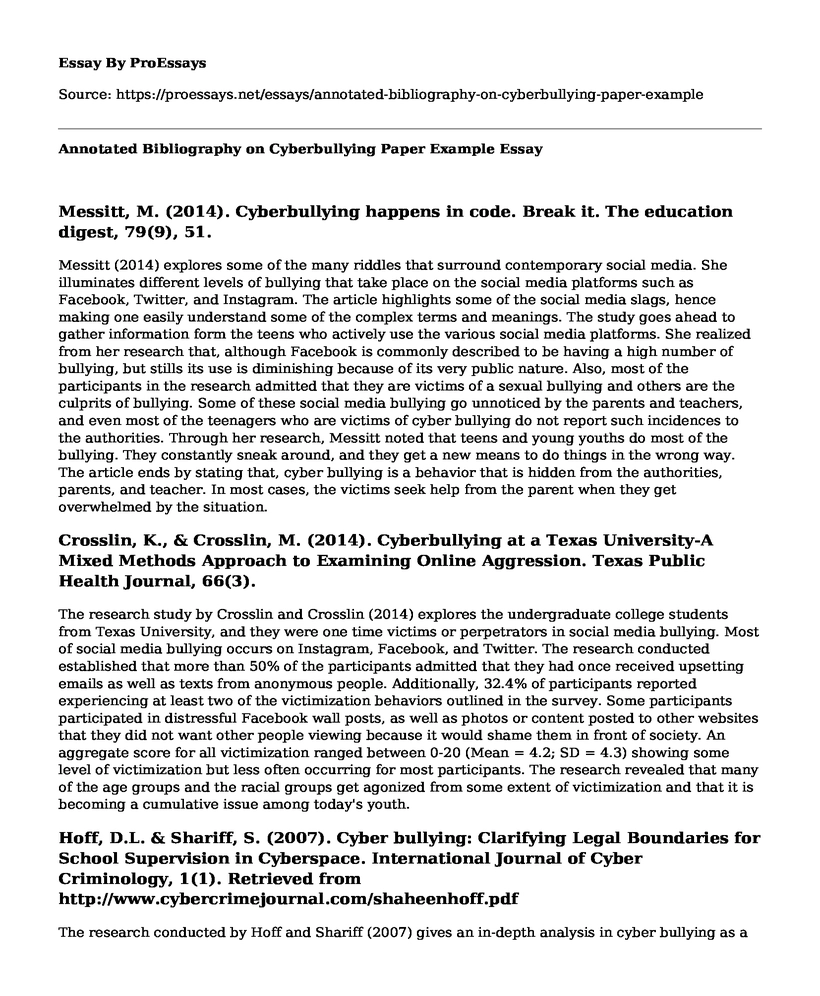Messitt, M. (2014). Cyberbullying happens in code. Break it. The education digest, 79(9), 51.
Messitt (2014) explores some of the many riddles that surround contemporary social media. She illuminates different levels of bullying that take place on the social media platforms such as Facebook, Twitter, and Instagram. The article highlights some of the social media slags, hence making one easily understand some of the complex terms and meanings. The study goes ahead to gather information form the teens who actively use the various social media platforms. She realized from her research that, although Facebook is commonly described to be having a high number of bullying, but stills its use is diminishing because of its very public nature. Also, most of the participants in the research admitted that they are victims of a sexual bullying and others are the culprits of bullying. Some of these social media bullying go unnoticed by the parents and teachers, and even most of the teenagers who are victims of cyber bullying do not report such incidences to the authorities. Through her research, Messitt noted that teens and young youths do most of the bullying. They constantly sneak around, and they get a new means to do things in the wrong way. The article ends by stating that, cyber bullying is a behavior that is hidden from the authorities, parents, and teacher. In most cases, the victims seek help from the parent when they get overwhelmed by the situation.
Crosslin, K., & Crosslin, M. (2014). Cyberbullying at a Texas University-A Mixed Methods Approach to Examining Online Aggression. Texas Public Health Journal, 66(3).
The research study by Crosslin and Crosslin (2014) explores the undergraduate college students from Texas University, and they were one time victims or perpetrators in social media bullying. Most of social media bullying occurs on Instagram, Facebook, and Twitter. The research conducted established that more than 50% of the participants admitted that they had once received upsetting emails as well as texts from anonymous people. Additionally, 32.4% of participants reported experiencing at least two of the victimization behaviors outlined in the survey. Some participants participated in distressful Facebook wall posts, as well as photos or content posted to other websites that they did not want other people viewing because it would shame them in front of society. An aggregate score for all victimization ranged between 0-20 (Mean = 4.2; SD = 4.3) showing some level of victimization but less often occurring for most participants. The research revealed that many of the age groups and the racial groups get agonized from some extent of victimization and that it is becoming a cumulative issue among today's youth.
Hoff, D.L. & Shariff, S. (2007). Cyber bullying: Clarifying Legal Boundaries for School Supervision in Cyberspace. International Journal of Cyber Criminology, 1(1). Retrieved from http://www.cybercrimejournal.com/shaheenhoff.pdf
The research conducted by Hoff and Shariff (2007) gives an in-depth analysis in cyber bullying as a crime, and the devastating impact it has towards the adolescents all over the world, together with explaining on what present boundaries limit school from resolving such issues. The researchers noted the high number of online cyber bullying is done through social media platforms. The book, "Lord of the Flies" is used alongside its characters as an analogy to the effect of cyber bullying among teens. Through the analysis of how cyber bullying is a crime, the levels of cyber bullying and to the reasons why kids are the part of cyber bullying are explored; and Hoff and Shariff (2007) present various cases of cyber bullying together with the legal action taken to the culprits. The research explores significant information that explains why cyber bullying through social media is essential issues that need some urgent attention. Legal aspects of social media crime together with the legal restrictions exist for schools that are ready to take action that will deter such crime from taking place. Also concerns of parents not being aware of the occurrences of social media bullying and how to tackle it is highlighted.
References
Crosslin, K., & Crosslin, M. (2014). Cyberbullying at a Texas University-A Mixed Methods Approach to Examining Online Aggression. Texas Public Health Journal, 66(3).
Hoff, D.L. & Shariff, S. (2007). Cyber bullying: Clarifying Legal Boundaries for School Supervision in Cyberspace. International Journal of Cyber Criminology, 1(1). Retrieved from http://www.cybercrimejournal.com/shaheenhoff.pdf
Messitt, M. (2014). Cyberbullying happens in code. Break it - the education digest, 79(9), 51.
Cite this page
Annotated Bibliography on Cyberbullying Paper Example. (2022, Dec 06). Retrieved from https://proessays.net/essays/annotated-bibliography-on-cyberbullying-paper-example
If you are the original author of this essay and no longer wish to have it published on the ProEssays website, please click below to request its removal:
- Essay Sample on Women and Gender in Islam
- Violent Video Games Influence a Player's Aggression Essay Example
- Zitkala-Sa and Jane Addams Essay Example
- Critical Essay on Racism in Brave New World
- Essay Example on Gender-Based Violence: A Global Menace to Social, Health Wellbeing
- Essay Example on Closing the Gender Wage Gap: What Needs To Be Done?
- Essay Example on Fast Food and Beverage Industry: Harms of Targeting Kids with Obesity







